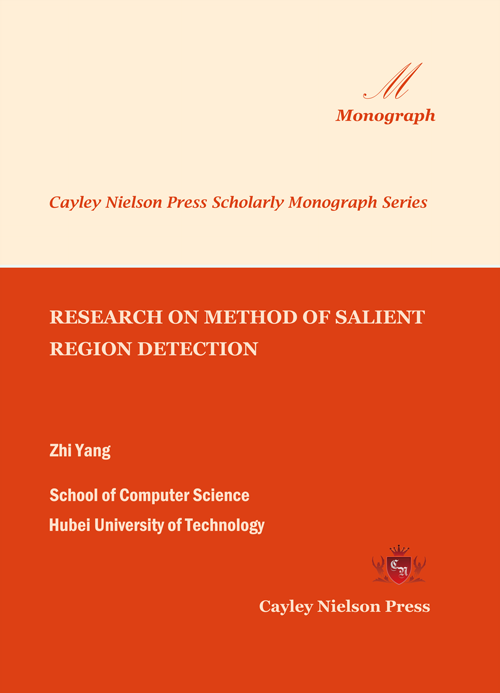
RESEARCH ON METHOD OF SALIENT REGION DETECTION

Zhi Yang
School of Computer Science
Hubei University of Technology
Copyright © 2021 by Cayley Nielson Press, Inc.
ISBN: 978-1-734882-5-4
Cayley Nielson Press Scholarly Monograph Series Book Code No.: 211-1-2
US$160.50
Contents
Preface I
Chapter 1: The Basics Knowledge of Saliency Detection 1
1.1 Introduction 1
1.2 Basic Concepts and Principles 3
1.2.1 Definition of visual saliency 3
1.2.2 Research background of visual saliency 5
1.3 Evaluation Method 5
1.3.1 Evaluation method of viewpoint prediction model 6
1.3.2 Evaluation method of salient region detection 8
Chapter 2: Region-Based Saliency Dectection on Diffusion Maps 10
2.1 Introduction 10
2.2 Method Overview 12
2.3 Build A Random Walk Based on Superpixels 13
2.3.1 Superpixel segmentation 13
2.3.2 Building a random walk matrix 16
2.4 Diffusion Maps and Diffusion Distance 18
2.4.1 Basic Concepts 18
2.4.2 Calculate the saliency value through the diffusion distance 21
2.5 Experiment and Result Analysis 22
2.5.1 Calculation steps 22
2.5.2 Parameter setting and experimental content 23
2.5.3 Fixed threshold segmentation 24
2.5.4 Comparative study with other methods 28
2.5.4.1 Saliency segmentation 33
2.5.4.2 Image reobjecting experiment 36
2.6 Summary of This Chapter 39
Chapter 3: Saliency Detection Based on Feature Fusion 42
3.1 Introduction 42
3.2 Description of Cross Diffusion Algorithm 44
3.2.1 Definition of basic concepts 44
3.2.2 The Cross Diffusion process of similarity matrix 46
3.3 Saliency Detection Based on Feature Fusion 47
3.3.1 Method flow description 47
3.3.2 Extraction of features 49
3.3.3 Calculation of initial saliency maps 51
3.3.4 Construction of similarity matrix 53
3.3.5 Cross Diffusion is used in saliency calculation 54
3.4 Experiment and Result Analysis 55
3.4.1 Calculation steps 55
3.4.2 Parameter setting and experimental content 56
3.4.3 Fusion of brightness, color and directional features 59
3.4.3.1 U(g) fuses with H(l) and H(a) 59
3.4.3.2 U(a) fuses with H(l) and H(g) 59
3.4.3.3 U(a) fuses with H(l) and H(g) 61
3.4.4 Fusion between color features 63
3.4.5 Discussion on the parameter t and the size of KNN 70
3.4.5.1 Discussion of the number of iterations t 70
3.4.5.2 Discussion of KNN parameters 71
3.4.6 Comparative study with other methods 73
3.4.7 Saliency segmentation 76
3.5 Summary 78
Chapter 4: Object-Based Salient Region Detection 80
4.1 Introduction 80
4.2 Method Overview 82
4.3 Data Preprocessing 83
4.4 Supervised Distance Metric Learning 86
4.4.1 Introduction to basic concepts 86
4.4.2 Distance metric learning applied to saliency calculation 88
4.5 Object Detection Is Used for Saliency Calculation 90
4.5.1 Introduction to basic concepts 90
4.5.2 Use general object detection algorithms to assist salient regoin detection 92
4.5.3 Fusion method of saliency map and general object detection results 97
4.6 Experiment and Result Analysis 98
4.6.1 Calculation steps 98
4.6.2 Parameter settings and experiment content 100
4.6.3 Two-stage treatment 102
4.6.4 Compared with other methods 104
4.6.4.1 Saliency segmentation 108
4.6.4.2 Image redirection 111
4.6.5 Comparative study with the other two methods proposed in our book 112
4.7 Summary of this Chapter 117
Chapter 5: Summary and Outlook 120
5.1 Summary of Research Work 120
5.2 Prospects for Follow-Up Research 122
References 124
Readership
This book should be useful for students, scientists, engineers and professionals working in the areas of optoelectronic packaging, photonic devices, semiconductor technology, materials science, polymer science, electrical and electronics engineering. This book could be used for one semester course on adhesives for photonics packaging designed for both undergraduate and graduate engineering students.
